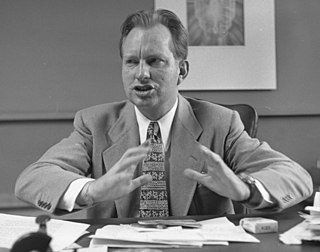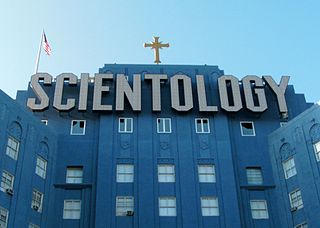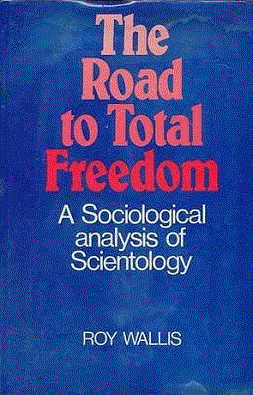
Lafayette Ronald Hubbard was an American author and the founder of Scientology. A prolific writer of pulp science fiction and fantasy novels in his early career, in 1950 he authored Dianetics: The Modern Science of Mental Health and established organizations to promote and practice Dianetics techniques. Hubbard created Scientology in 1952 after losing the intellectual rights to his literature on Dianetics in bankruptcy. He would lead the Church of Scientology, variously described as a cult, a new religious movement, or a business, until his death in 1986.

The Church of Scientology maintains a wide variety of beliefs and practices. The core belief holds that a human is an immortal, spiritual being (thetan) that is resident in a physical body. The thetan has had innumerable past lives, some of which, preceding the thetan's arrival on Earth, were lived in extraterrestrial cultures. Based on case studies at advanced levels, it is predicted that any Scientologist undergoing auditing will eventually come across and recount a common series of past-life events.

R2-45 is Scientology slang for murder or suicide by gun. Scientology founder L. Ron Hubbard described it as "an enormously effective process for exteriorization but its use is frowned upon by this society at this time". In Scientology doctrine, exteriorization refers to the separation of the thetan (soul) from the body, a phenomenon which Hubbard asserts can be achieved through Scientology auditing. R2-45 is said to be a process by which exteriorization could be produced by shooting a person in the head with a .45 caliber pistol. This literal meaning is acknowledged by the Church of Scientology, although they deny that it is meant seriously.

The Foster Report is a 1971 report titled Enquiry into the Practice and Effects of Scientology, written by Sir John Foster for the government of the United Kingdom, regarding the Church of Scientology. The report made its case with L. Ron Hubbard's own words and reprinted a number of the Church's internal Ethics Orders. It did not ban Scientology outright, but asked for legislation to ensure that psychotherapy in the United Kingdom is "a restricted profession open only to those who undergo an appropriate training and are willing to adhere to a proper code of ethics," and that the Scientology ethics and justice system did not meet such criteria.

The Church of Scientology is a group of interconnected corporate entities and other organizations devoted to the practice, administration and dissemination of Scientology, which is variously defined as a cult, a business, or a new religious movement. The movement has been the subject of a number of controversies, and the Church of Scientology has been described by government inquiries, international parliamentary bodies, scholars, law lords, and numerous superior court judgements as both a dangerous cult and a manipulative profit-making business. In 1979, several executives of the organization were convicted and imprisoned for multiple offenses by a U.S. Federal Court. The Church of Scientology itself was convicted of fraud by a French court in 2009, a decision upheld by the supreme Court of Cassation in 2013. The German government classifies Scientology as an unconstitutional sect. In France, it has been classified as a dangerous cult. In some countries, it has attained legal recognition as a religion.
Scientology terminology consists of a complex assortment of jargon used by Scientologists in conjunction with the practice of Scientology and in their everyday lives. It is difficult if not impossible to understand Scientology without understanding its terminology the way Hubbard defines it.
In the 1950s and 1960s, a HASI was an organization where people would go for Scientology training, auditing, books, tapes, and e-meters. There were HASI organizations across the western world. The use of the word "HASI", pronounced "hah-zee" or "ha-zee", could refer to either a local organization or the international management corporation.
[L. Ron Hubbard] is governing director of Hubbard Association of Scientologists International, the operative company of the HASI, over which he exercises complete and autocratic control.

Ronald Edward "Ron" DeWolf, also known as "Nibs" Hubbard, was the eldest child of Scientology's founder L. Ron Hubbard by his first wife Margaret Louise Grubb. He is known for having been highly critical of his father and of the Church of Scientology. In his opinion, Scientology was a cult that existed to make money.

A Piece of Blue Sky: Scientology, Dianetics and L. Ron Hubbard Exposed is a 1990 book about L. Ron Hubbard and the development of Dianetics and Scientology, authored by British former Scientologist Jon Atack. It was republished in 2013 with the title Let's sell these people A Piece of Blue Sky: Hubbard, Dianetics and Scientology. The title originates from a quote of Hubbard from 1950; an associate of Hubbard's noted him saying that he wanted to sell potential members "a piece of blue sky".
The Church of Scientology publicly classifies itself as a religion, but scholars and other observers regard it as a business, because the organization operates more like a for-profit business than a religious institution. Some scholars of sociology working in religious studies consider it a new religious movement. Overall, as stated by Stephen A. Kent, Scientology can be seen as a "multi-faceted transnational corporation that has religion as only one of its many components. Other components include political aspirations, business ventures, cultural productions, pseudo-medical practices, pseudo-psychiatric claims, and, an alternative family structure."

This bibliography of Scientology includes Scientology and Dianetics-related books, periodicals and other issues authored by L. Ron Hubbard and those produced by the Church of Scientology and its related organizations. Books bearing L. Ron Hubbard's name are considered texts of Scientology's canon.
The amount of material on Dianetics and Scientology is extensive, to say the least. This material is composed of books by L. Ron Hubbard ; compilations of his works; taped lectures; auditor training materials ; course packages; booklets; a large number of magazines and annuals; and video recordings of the major annual events.

L. Ron Hubbard, Messiah or Madman? is a posthumous biography of Scientology founder L. Ron Hubbard written by Bent Corydon, which makes extensive use of interviews he conducted with Hubbard's son Ronald DeWolf. Though originally published in 1987 by Lyle Stuart Inc., the book was re-issued in a paperback edition on July 25, 1992, and a hardcover edition in October 1995, both by publisher Barricade Books. The 1995 edition also featured Brian Ambry as principal researcher. The first edition of the book listed DeWolf as coauthor.

The Scandal of Scientology is a critical exposé book about the Church of Scientology, written by Paulette Cooper and published by Tower Publications, in 1971.

Scientology: The Now Religion is a book on Scientology, written by George Malko. The book was the first full-length analysis of the history surrounding the founding of the Church of Scientology, and L. Ron Hubbard. The author conducted interviews with members, and provides analysis about certain practices. The book was published in 1970 in Hardcover format by Delacorte Press, and then in a paperback edition in 1971, by Dell Publishing. The Church of Scientology fought to prevent the sale of the book.

The training routines (TR) are training exercises or drills used in the Church of Scientology as well as affiliated programs Narconon, Criminon, WISE, and Applied Scholastics. The church describes them as a way of learning to communicate effectively and to control situations. Some critics and former Scientologists claim the training routines have a strong hypnotic effect, causing hallucinations and an out-of-body experience known in Scientology as "exteriorization.
The Training Routines that are part of early Scientology indoctrination have been compared to acting exercises: students are taught to "duplicate," or mirror, a partner's actions; project their "intention," or thoughts, onto inanimate objects; experiment with vocal tones, the most dominant being a commanding bark known as "tone 40"; and deepen their ability to "be in their bodies" without reacting to outside stimuli.

The Road to Total Freedom: A Sociological Analysis of Scientology is a non-fiction book about Scientology by sociologist Roy Wallis. Originally published in 1976 by Heinemann, it was republished in 1977 by Columbia University Press. The original manuscript was the product of Wallis's doctoral research at Oxford under the tutelage of Bryan Wilson. Wallis, after a review of the original manuscript by Scientology leaders, made edits to about 100 passages before publication.

The Advanced Ability Center was a breakaway organization from the Church of Scientology established by former Scientologist David Mayo after he left the Church in February 1983 – a time when most of Scientology's upper and middle management was removed following the formation of the Religious Technology Center (RTC) and RTC head David Miscavige's restructuring of the church. David Mayo had been Hubbard's own auditor. The Advanced Ability Center later became the Theta International movement and was also known as the Church of the New Civilization.

The Church of Scientology network operates as a multinational conglomerate of companies with personnel, executives, organizational charts, chains of command, policies and orders.
Religious Technology Center is the most powerful executive organization within the Scientology empire, and its current chairman, David Miscavige, is widely recognized as the effective head of the church.
This is a bibliography of books critical of Scientology and the Church of Scientology, sorted by alphabetical order of titles.











